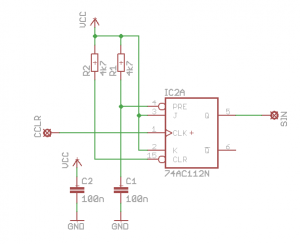ACID Verilog code
Nilquader and I decided to release our Verilog code (based on Nocash’s decryption of the algorithm) to “emulate” the ACID protection chip of the Amstrad Plus. So, you can now find it here (for more information have a look at the [[Amstrad Cartridge Identification Device|ACID article]] of the CPCWiki):
`timescale 1ns / 1ps
//////////////////////////////////////////////////////////////////////////////////
// Company:
// Engineer: Octoate, Nilquader
// ACID Reverse engineering by nocash
//
// Create Date : 00:45:53 09/03/2010
// Design Name : amsacid
// Module Name : amsacid
// Project Name :
// Target Devices: Xilinx XC9572
// Tool versions :
// Description : Reverse engineered Amstrad 40908 "ACID" Chip
//
// Revision:
// Revision 0.05
// Additional Comments:
//
//////////////////////////////////////////////////////////////////////////////////
module amsacid(PinCLK, PinA, PinOE, PinCCLR, PinSIN);
input PinCLK;
input [7:0]PinA;
input PinOE;
input PinCCLR;
output [7:0]PinSIN;
wire PinCLK;
reg [16:0]ShiftReg = 17'h1FFFF;
wire [16:0]CmpVal;
wire [16:0]XorVal;
assign CmpVal = 17'h13596 ^ (PinA[0] ? 17'h0000c : 0)
^ (PinA[1] ? 17'h06000 : 0)
^ (PinA[2] ? 17'h000c0 : 0)
^ (PinA[3] ? 17'h00030 : 0)
^ (PinA[4] ? 17'h18000 : 0)
^ (PinA[5] ? 17'h00003 : 0)
^ (PinA[6] ? 17'h00600 : 0)
^ (PinA[7] ? 17'h01800 : 0);
assign XorVal = 17'h0C820 ^ (PinA[0] ? 17'h00004 : 0)
^ (PinA[1] ? 17'h06000 : 0)
^ (PinA[2] ? 17'h00080 : 0)
^ (PinA[3] ? 17'h00020 : 0)
^ (PinA[4] ? 17'h08000 : 0)
^ (PinA[5] ? 17'h00000 : 0)
^ (PinA[6] ? 17'h00000 : 0)
^ (PinA[7] ? 17'h00800 : 0);
always@(negedge PinCLK)
begin
if (PinCCLR) // not in reset state
begin
if (!PinOE && ((ShiftReg | 17'h00100) == CmpVal))
begin
ShiftReg <= (ShiftReg ^ XorVal) >> 1;
ShiftReg[16] <= ShiftReg[0] ^ ShiftReg[9] ^ ShiftReg[12] ^ ShiftReg[16] ^ XorVal[0]; // hier xorval mit berüchsichtigen
end
else
begin
ShiftReg <= ShiftReg >> 1;
ShiftReg[16] <= ShiftReg[0] ^ ShiftReg[9] ^ ShiftReg[12] ^ ShiftReg[16];
end
end
else
begin
ShiftReg <= 17'h1FFFF;
end
end
//assign PinSIN = ShiftReg[7:0] ^ 8'hff;
assign PinSIN = ShiftReg[7:0];
//assign PinSIN[0] = PinCLK;
endmodule
But this isn’t everything about the ACID. We also found a timing problem during the investigation with a logic analyzer, which you can see here:
You will find glitches on the /CCLR line which show that the SIN contact should be changed… All in all it is possible to use a fast flip-flop to change the SIN signal when such a glitch occurs (see picture below).
So, have fun with it :-).



[…] or the Symbiface II) and we are also able to produce new cartridges for the Amstrad Plus since the ACID chip was reverse engineered, but we are missing more ROM games. You can read more about the competition (e.g. the rules, the […]
[…] After years of inactivity I decided to release two old project, which I started to work on in 2010, publicly on my GitHub account. I have not produced any prototypes yet, so they are currently more a draft. Both projects use a flash EPROM to store the data in the cartridge. The first one is a simple Amstrad Plus / Amstrad GX4000 cartridge, which can be equipped with an original ACID protection chip or with a Xilinx XC9536 CPLD for ACID emulation (you can read more about the emulation here). […]